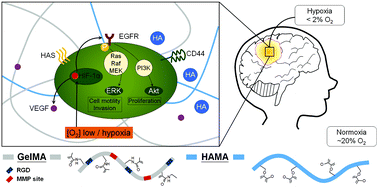当前位置:
X-MOL 学术
›
Biomater. Sci.
›
论文详情
Our official English website, www.x-mol.net, welcomes your feedback! (Note: you will need to create a separate account there.)
Hypoxia activates enhanced invasive potential and endogenous hyaluronic acid production by glioblastoma cells†
Biomaterials Science ( IF 6.6 ) Pub Date : 2018-02-21 00:00:00 , DOI: 10.1039/c7bm01195d Jee-Wei Emily Chen 1, 2, 3, 4, 5 , Jan Lumibao 2, 3, 4, 5, 6 , Audrey Blazek 2, 3, 4, 7 , H. Rex Gaskins 2, 3, 4, 5, 6 , Brendan Harley 1, 2, 3, 4, 5
Biomaterials Science ( IF 6.6 ) Pub Date : 2018-02-21 00:00:00 , DOI: 10.1039/c7bm01195d Jee-Wei Emily Chen 1, 2, 3, 4, 5 , Jan Lumibao 2, 3, 4, 5, 6 , Audrey Blazek 2, 3, 4, 7 , H. Rex Gaskins 2, 3, 4, 5, 6 , Brendan Harley 1, 2, 3, 4, 5
Affiliation

|
Glioblastoma (GBM) is the most common, aggressive, and deadly form of adult brain cancer, and is associated with a short survival rate (median 12–15 months, 5+ year less than 5%). The complex tumor microenvironment includes matrix transitions at the tumor margin, such as gradations in hyaluronic acid (HA). In addition, metabolic stress induced by decreased oxygen content across the tumor may contribute to tumor progression. However, cross-talk between matrix composition and metabolic stress remains unclear. In this study, we fabricated an in vitro brain memetic HA-decorated gelatin hydrogel platform incorporating variable oxygen concentrations to mimic intra-tumoral hypoxia. We observed that EGFR status (wildtype vs. a constitutively active EGFRvIII mutant) of U87 GBM cells affected proliferation and metabolic activity in response to hypoxia and matrix-bound HA. The use of an invasion assay revealed that invasion was significantly enhanced in both cell types under hypoxia. Moreover, we observed compensatory secretion of soluble HA in cases of enhanced GBM cell invasion, consistent with our previous findings using other GBM cell lines. Interestingly, U87 GBM cells adapted to hypoxia by shifting toward a more anaerobic metabolic state, a mechanism that may contribute to GBM cell invasion. Collectively, these data demonstrate that the use of a three-dimensional hydrogel provides a robust method to study the impact of matrix composition and metabolic challenges on GBM cell invasion, a key factor contributing to the most common, aggressive, and deadly form of adult brain cancer.
中文翻译:

低氧激活胶质母细胞瘤细胞增强的侵袭潜能和内源性透明质酸的产生†
胶质母细胞瘤(GBM)是成人脑癌的最常见,侵袭性和致命形式,其存活率短(中位12–15个月,超过5年的患者少于5%)。复杂的肿瘤微环境包括肿瘤边缘处的基质转变,例如透明质酸(HA)中的渐变。另外,由肿瘤中氧含量降低引起的代谢应激可能有助于肿瘤进展。然而,基质组成和代谢应激之间的串扰仍然不清楚。在这项研究中,我们制造了一个体外脑模拟HA修饰的明胶水凝胶平台,该平台结合了可变的氧浓度来模拟肿瘤内的缺氧。我们观察到EGFR状态(野生型与组成性活性EGFR vIIIU87 GBM细胞的突变体)响应缺氧和基质结合型HA而影响增殖和代谢活性。侵袭试验的使用表明,在缺氧条件下,两种细胞类型的侵袭均得到明显增强。此外,我们观察到在GBM细胞侵袭增加的情况下可溶性HA的代偿性分泌,这与我们先前使用其他GBM细胞系的发现一致。有趣的是,U87 GBM细胞通过向更无氧的代谢状态转变而适应了低氧,这可能是GBM细胞入侵的一种机制。总体而言,这些数据表明,三维水凝胶的使用提供了一种可靠的方法来研究基质成分和代谢挑战对GBM细胞侵袭的影响,而GBM细胞侵袭是导致成人大脑最常见,具有攻击性和致命形式的关键因素癌症。
更新日期:2018-02-21
中文翻译:

低氧激活胶质母细胞瘤细胞增强的侵袭潜能和内源性透明质酸的产生†
胶质母细胞瘤(GBM)是成人脑癌的最常见,侵袭性和致命形式,其存活率短(中位12–15个月,超过5年的患者少于5%)。复杂的肿瘤微环境包括肿瘤边缘处的基质转变,例如透明质酸(HA)中的渐变。另外,由肿瘤中氧含量降低引起的代谢应激可能有助于肿瘤进展。然而,基质组成和代谢应激之间的串扰仍然不清楚。在这项研究中,我们制造了一个体外脑模拟HA修饰的明胶水凝胶平台,该平台结合了可变的氧浓度来模拟肿瘤内的缺氧。我们观察到EGFR状态(野生型与组成性活性EGFR vIIIU87 GBM细胞的突变体)响应缺氧和基质结合型HA而影响增殖和代谢活性。侵袭试验的使用表明,在缺氧条件下,两种细胞类型的侵袭均得到明显增强。此外,我们观察到在GBM细胞侵袭增加的情况下可溶性HA的代偿性分泌,这与我们先前使用其他GBM细胞系的发现一致。有趣的是,U87 GBM细胞通过向更无氧的代谢状态转变而适应了低氧,这可能是GBM细胞入侵的一种机制。总体而言,这些数据表明,三维水凝胶的使用提供了一种可靠的方法来研究基质成分和代谢挑战对GBM细胞侵袭的影响,而GBM细胞侵袭是导致成人大脑最常见,具有攻击性和致命形式的关键因素癌症。



























 京公网安备 11010802027423号
京公网安备 11010802027423号